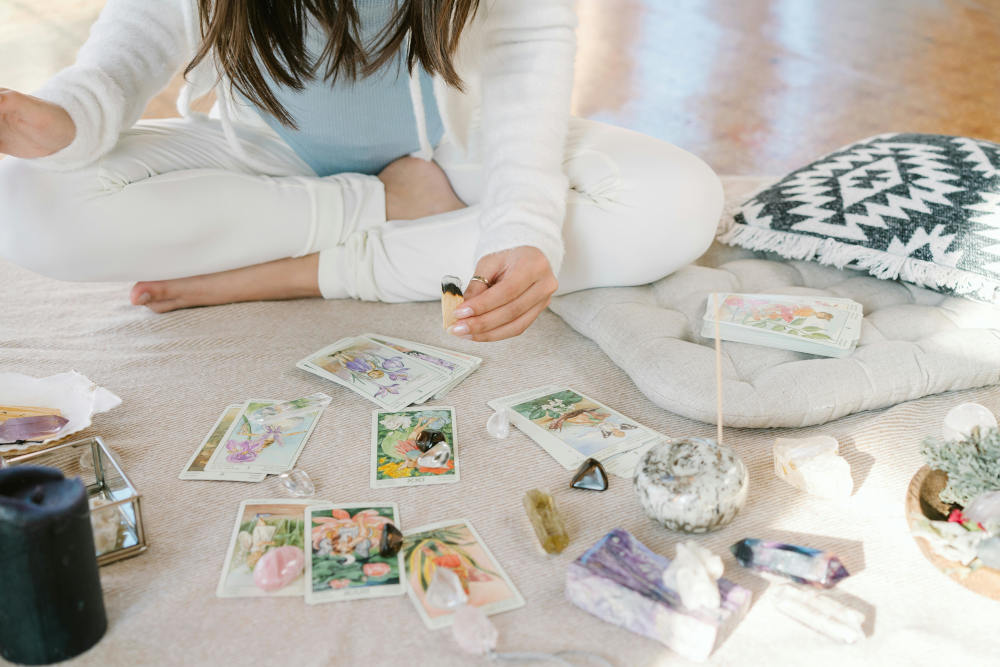
Das erste Mal eine Tarot-Lesung zu bekommen, kann mysteriös, aufregend oder sogar ein wenig einschüchternd sein. Egal, ob Sie Einblicke in Ihre Zukunft, Klarheit über eine Situation oder einfach nur Neugier auf den Ablauf suchen – das Verständnis dessen, was während einer Tarot-Lesung tatsächlich passiert, kann Ihnen helfen, sich zu entspannen und das Erlebnis bedeutungsvoller zu gestalten.
In diesem Artikel erklären wir Ihnen, was Sie vor, während und nach einer Tarot-Lesung erwartet. Sie erfahren, wie eine Tarot-Lesung funktioniert, welche Fragen Sie stellen können, wie Sie sich vorbereiten und was die Karten Ihnen sagen können – und was nicht .
Panaprium ist unabhängig und wird vom Leser unterstützt. Wenn Sie über unseren Link etwas kaufen, erhalten wir möglicherweise eine Provision. Wenn Sie können, unterstützen Sie uns bitte monatlich. Die Einrichtung dauert weniger als eine Minute und Sie werden jeden Monat einen großen Beitrag leisten. Danke schön!
Was ist eine Tarot-Lesung?
Eine Tarot-Lesung ist eine Form der Wahrsagerei, bei der ein Kartenspiel mit 78 Karten verwendet wird, um Einblicke in das Leben einer Person zu gewinnen. Die Leser interpretieren die Symbolik, die Bilder und die Position jeder Karte, um Orientierung, Reflexion oder spirituelle Botschaften zu vermitteln.
Es ist wichtig zu beachten, dass es beim Tarot nicht darum geht, Ihr Schicksal mit 100%iger Sicherheit vorherzusagen . Vielmehr ist es ein Werkzeug für:
-
Selbstreflexion
-
Aktuelle Energien verstehen
-
Mögliche Ergebnisse erkunden
-
Klärung von Entscheidungen
Eine Tarot-Lesung ist wie ein Spiegel Ihrer inneren Welt. Sie hilft Ihnen zu erkennen, was Ihre Gedanken, Gefühle und Entscheidungen beeinflusst.
Vor der Lesung: Was Sie erwartet
1. Auswahl eines Lesers
Tarotkartenleser gibt es in allen Stilen – manche sind spirituell oder intuitiv, andere praktisch und bodenständig. Manche legen professionell in metaphysischen Geschäften oder online, während andere gelegentliche Lesungen auf Märkten oder Veranstaltungen anbieten.
Bedenken Sie vor der Buchung:
-
Ihr Lesestil : Konzentrieren sie sich auf Vorhersagen, Heilung, Psychologie oder Ermächtigung?
-
Bewertungen oder Erfahrungsberichte
-
Ethischer Ansatz : Ein guter Leser wird niemals behaupten, „Flüche zu beseitigen“ oder Sie zum Kauf weiterer Dienste zu zwingen.
2. Festlegen der Absicht
Manche Leser bitten Sie, sich vor Beginn der Lesung auf eine Frage oder ein Thema zu konzentrieren. Sie brauchen nicht immer eine konkrete Frage – allgemeine Hinweise sind auch in Ordnung –, aber eine bestimmte Absicht hilft, die Lesung zu gestalten.
Gute Fragen könnten sein:
-
„Was sollte ich über meine aktuelle Beziehung wissen?“
-
„Welche Energie umgibt meinen Karriereweg?“
-
„Worauf muss ich mich für mein persönliches Wachstum konzentrieren?“
Vermeiden Sie Ja/Nein-Fragen und konzentrieren Sie sich stattdessen auf offene, reflektierende Aufforderungen.
3. Persönliche Lesungen vs. Online-Lesungen
-
Bei persönlichen Lesungen können Kerzen, Kristalle oder Weihrauch zum Einsatz kommen, um einen heiligen Raum zu schaffen.
-
Online-Lesungen (über Zoom, Video, E-Mail oder Chat) sind genauso effektiv, da die Energie nicht durch den physischen Raum begrenzt ist.
Während der Lesung: Schritt für Schritt
1. Deckauswahl
Manche Leser verwenden ausschließlich ein Tarotdeck, während andere Ihnen die Wahl lassen. Je nach Praxis können sie auch Orakelkarten oder andere Wahrsagewerkzeuge verwenden.
2. Reinigen oder Mischen
Zu Beginn mischt der Kartenleger die Karten – manchmal bittet er Sie dabei, Ihre Energie oder Ihre Frage zu fokussieren. Möglicherweise werden Sie gebeten, das Deck selbst (persönlich) zu mischen oder abzuheben, um Ihre Energie auf die Karten zu übertragen.
Einige Leser reinigen das Deck zwischen den Lesungen mit Salbei, Kristallen oder der Absicht, Restenergie zu beseitigen.
3. Einen Spread auswählen
Ein Spread ist die Anordnung der Karten, die den Ablauf der Lesung bestimmt. Gängige Spreads sind:
-
One-Card Pull : Schneller Einblick oder tägliche Anleitung
-
Drei-Karten-Legung : Vergangenheit / Gegenwart / Zukunft oder Situation / Hindernis / Rat
-
Keltisches Kreuz : Eine detailliertere 10-Karten-Legung, die Einflüsse, Hoffnungen, Ängste und wahrscheinliche Ergebnisse zeigt
-
Beziehungs-Spread : Einblicke in romantische oder zwischenmenschliche Dynamiken
-
Karriere-Spread : Konzentriert auf Arbeit, Ziele und Entscheidungen
Der Leser wählt eine Seite basierend auf Ihrer Frage oder Absicht aus.
4. Interpretation der Karten
Der Leser dreht die Karten nacheinander um und interpretiert ihre Bedeutung anhand folgender Kriterien:
-
Kartenbilder und Symbolik
-
Kartenposition im Spread
-
Beziehung zwischen Karten
-
Aufrechte vs. umgekehrte Position (einige Leser verwenden umgekehrte Karten, um Blockaden oder entgegengesetzte Bedeutungen anzuzeigen)
Beispielsweise könnten die Liebenden in einer Beziehungsgeschichte auf Verbundenheit oder Entscheidung hindeuten, während der Turm auf plötzliche Veränderungen oder Umwälzungen hinweisen könnte. Die genaue Interpretation hängt jedoch vom Kontext ab.
5. Konversation und Einsicht
Die besten Tarot-Lesungen sind gemeinschaftlich. Ein guter Leser kann Ihnen Fragen stellen, nach Ihren Wünschen fragen oder Interpretationen anbieten, die Ihre Meinung einladen.
Manche Leser sind sehr intuitiv und konzentrieren sich auf Botschaften, die sie durch Energie erhalten, während andere sich eher an die traditionellen Kartenbedeutungen halten.
Denken Sie daran, dass Sie nicht nur ein passiver Beobachter sind – Ihre Gedanken, Gefühle und Reaktionen sind Teil des Leseprozesses.
Was Sie davon haben
Eine Tarot-Lesung kann viele Arten von Erkenntnissen bieten, je nachdem, wonach Sie suchen:
1. Klarheit
Wenn Sie verwirrt sind oder nicht weiterkommen, können die Karten widerspiegeln, was vor sich geht, und eine neue Perspektive bieten.
2. Validierung
Manchmal bestätigen die Karten, was Sie tief im Inneren bereits wissen, aber noch nicht zur Kenntnis genommen haben.
3. Optionen und Ergebnisse
Tarot sagt Ihnen nicht, was definitiv passieren wird – es zeigt mögliche Wege auf der Grundlage Ihrer aktuellen Energie oder Entscheidungen.
4. Emotionale Unterstützung
Viele Menschen finden Trost in einer Lesung, insbesondere in Zeiten der Trauer, Unsicherheit oder großer Lebensübergänge.
Was Tarot nicht kann
Obwohl Tarot ein mächtiges Werkzeug ist, ist es wichtig, realistische Erwartungen zu haben:
-
Es lässt sich die Zukunft nicht mit 100-prozentiger Sicherheit vorhersagen . Freier Wille, persönliches Wachstum und Lebensumstände sind immer in Bewegung.
-
Es kann die professionelle Beratung durch Ärzte, Therapeuten oder Rechtsexperten nicht ersetzen .
-
Es wird Ihre Probleme nicht für Sie „lösen“ , sondern Ihnen den Weg zeigen, aber Sie müssen ihn trotzdem gehen.
Vermeiden Sie Leser, die behaupten, Zaubersprüche zu beherrschen, Flüche aufzuheben oder übertrieben dramatische Warnungen aussprechen – dies sind oft Warnzeichen für Betrug.
Nach der Lesung: Integration und Reflexion
1. Machen Sie sich Notizen oder zeichnen Sie auf
Wenn möglich, notieren Sie sich, welche Karten aufgetaucht sind und was der Leser gesagt hat. Viele Erkenntnisse kommen erst später, wenn Sie Zeit zum Nachdenken hatten.
2. Emotional verarbeiten
Manchmal weckt eine Lesung tiefe Emotionen. Nehmen Sie sich Zeit, um über die Ereignisse nachzudenken, ein Tagebuch darüber zu führen oder mit jemandem Ihres Vertrauens darüber zu sprechen.
3. Achten Sie auf Synchronizitäten
Viele Menschen bemerken nach einer Lesung Zeichen, Träume oder wiederkehrende Themen. Dies kann die Art und Weise des Universums sein, die Botschaft zu bestätigen.
4. Handeln Sie
Nutzen Sie das Gelernte, um fundierte Entscheidungen zu treffen. Tarot funktioniert am besten, wenn es mit realen Handlungen kombiniert wird.
Häufige Missverständnisse über Tarot-Lesungen
1. „Die Karten werden mir meine Zukunft vorhersagen.“
Tarot zeigt mögliche Ergebnisse basierend auf der aktuellen Energie. Sie haben jederzeit die Macht, Ihren Weg zu ändern.
2. „Wenn ich eine ‚schlechte‘ Karte bekomme, wird etwas Schlimmes passieren.“
Karten wie „Tod“ , „Der Turm“ oder „Zehn der Schwerter“ werden oft missverstanden. Normalerweise stehen sie für eine notwendige Transformation, Befreiung oder einen Wendepunkt – nicht für den Untergang.
3. „Tarot ist böse oder gegen meine Religion.“
Tarot ist nicht zwangsläufig an eine Religion gebunden. Es ist ein spirituelles Werkzeug, keine übernatürliche Kraft. Viele Menschen nutzen es zur Reflexion, Achtsamkeit und persönlichen Weiterentwicklung.
4. „Man muss übersinnliche Fähigkeiten haben, um Tarotkarten zu lesen.“
Stimmt nicht! Jeder kann Tarot lernen. Intuition ist zwar hilfreich, aber Tarotlesen ist eine Fähigkeit, die Sie durch Lernen und Übung entwickeln können.
Wie oft sollten Sie sich die Tarotkarten legen lassen?
Es gibt keine feste Regel. Manche Menschen erhalten Messwerte:
-
Wöchentlich zur Orientierung
-
Monatlich zur Zielsetzung
-
Saisonal für die Gesamtplanung
-
Nur während Übergängen wie Trennungen, Jobwechseln oder spirituellem Erwachen
Hören Sie auf Ihre innere Stimme. Zu viele Lesungen können verwirrend sein, wenn Sie sich bei jeder Entscheidung zu sehr auf sie verlassen.
Abschließende Gedanken
Eine Tarot-Lesung kann eine kraftvolle und bestärkende Erfahrung sein. Egal, ob es Ihr erstes oder Ihr fünfzigstes Mal ist, jede Lesung bietet Ihnen die Möglichkeit, innezuhalten, nach innen zu schauen und auf Ihre Intuition zu hören.
Es geht nicht um magische Antworten, sondern um sinnvolle Reflexion. Die Karten treffen keine Entscheidungen für dich; sie helfen dir, die Weisheit zu entdecken, die bereits in dir steckt.
Wenn Sie also neugierig auf eine Tarot-Lesung sind, gehen Sie mit offenem Geist und Herzen an die Sache heran. Sie werden vielleicht überrascht sein, was die Karten zu sagen haben.
War dieser Artikel hilfreich für Sie? Bitte teilen Sie uns in den Kommentaren unten mit, was Ihnen gefallen oder nicht gefallen hat.
About the Author: Alex Assoune
Wogegen Wir Kämpfen
Weltweit-Konzerne produzieren in den ärmsten Ländern im Übermaß billige Produkte.
Fabriken mit Sweatshop-ähnlichen Bedingungen, die die Arbeiter unterbezahlt.
Medienkonglomerate, die unethische, nicht nachhaltige Produkte bewerben.
Schlechte Akteure fördern durch unbewusstes Verhalten den übermäßigen Konsum.
- - - -
Zum Glück haben wir unsere Unterstützer, darunter auch Sie.
Panaprium wird von Lesern wie Ihnen finanziert, die sich unserer Mission anschließen möchten, die Welt völlig umweltfreundlich zu gestalten.
Wenn Sie können, unterstützen Sie uns bitte monatlich. Die Einrichtung dauert weniger als eine Minute und Sie werden jeden Monat einen großen Beitrag leisten. Danke schön.































0 Kommentare